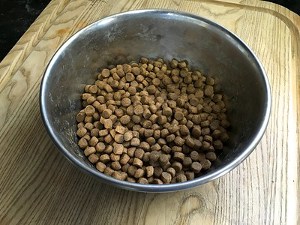
Five and a half years ago, we moved our dogs from kibble to raw food.
And don’t worry, this isn’t the start of a lecture extolling the virtues of how great raw food is
But it is a story of how big and noticeable one of the changes was after making a switch.
We have three golden retrievers- large to medium sized dogs who, as largish dogs, poop quite a bit.
Having three dogs meant that the first 10 minutes of the walk in our local park was always a bit stressful.
Once off the lead, they ran off, sniffing here, pooping there.
Spotting where each of them pooped was a stressful process particularly when they were on a kibble diet because they each pooped more than once.
I hated it, particularly in autumn when their mess blended in with the leaves on the grass.
As they started on their raw food, this all changed and I didn’t quite realise why at the time.
Instead of squatting two or three times in the park, they just squatted once.
The difference in the amount of poop was simply astonishing.
But what is it in kibble that makes dogs poop more?
And in this next section, I want to draw a comparison between kibble and canned foods.
The differences between kibble and canned food?
I’m going to cut to the chase here.
There is one major reason that your dog will probably poop more if you feed them kibble than if you feed them canned food.
Fiber.
Kibble has a much greater fiber content than canned food and to demonstrate this I’m going to compare a popular kibble and a popular canned food.
And to make it even fairer, I have chosen some kibble food and some canned food from the same company- Pedigree.
One of the most famous dog food companies in the world- Pedigree.
| Pedigree Adult Dry Kibble | Pedigree Choice Cuts Canned | |
| Protein (min.) | 21% | 8.5% |
| Fat (min.) | 10% | 3% |
| Fiber (max.) | 4% | 1% |
| Moisture (max.) | 12% | 82% |
Although this chart contains lots of interesting information, the most interesting is that the kibble has typically four times as much fiber in it than canned food.
4% compared to 1%
The importance of fiber in pooping
It is the same for dogs as it is for people.
Fiber makes “stools more bulky, increases the frequency of bowel movements and makes the process of passing bowel motions easier.”
As well as fiber, another important ingredient in this process is water.
And this is ironic given that canned food contains seven times more “moisture” than kibble
Having looked at overall percentages, in the next section I want to take a look at how individual ingredients might make your dog poop more.
How do different ingredients make dogs poop more?
The chart below shows the “biggest” ingredients that appear in the kibble and the can.
| Pedigree Adult Dry Kibble | Pedigree Choice Cuts Canned |
| Whole grain corn | Water |
| Meat and bone meal | Chicken |
| Corn gluten meal | Meat by products |
| Animal fat | Wheat Flour |
| Soybean meal | Beef |
And there are some key differences here.
Kibble has a reputation of being full of fillers or carbohydrates only some of which will be absorbed by the body and most of which will be gotten rid of via poop!
And in the top five ingredients, I would identify three of them as being “fillers.”
These are designed to provide food with the correct texture, weight and shape.
The biggest ingredient in the kibble is whole grain corn, which a quick look at my nutrition tool tells me is 77% carbohydrate and contains 7% fiber– which is a nutrient that your body can’t digest.
Added to that are corn gluten meal and soybean meal which are rich sources of protein.
But soybeans are also high in fiber, which is also great for our dog’s health but because of this eating them will also result in more poop.
Compare this to the cans of Pedigree.
Three of the five biggest ingredients aren’t fillers.
Unless of course that you count water as a filler (which you might do) but is a filler ingredient that shouldn’t lead to your dog pooping more!
Chicken, meat by-products and beef are also in this list.
Which like the soy and corn meal are protein rich but just with much less fiber.
A quick look at the fiber content of ground chicken or ground beef shows that it has none: a big, fat 0%.
Is kibble better than canned dog food?
It is hard to beat the convenience of kibble.
It tends to be cheaper to buy than canned food because your dog eats less of it oz for oz than they would cans.
Buying both kibble and cans in bulk is tricky because they are just so heavy.
But I think that lugging around a 33 lb bag of kibble out of a shop might be a little easier than buying the equivalent amount of cans.
Which for my three dogs might look something like a U.N. food drop.
But having 3 months of frozen raw food delivered in one go, is a thankless task.
The thought of carrying all of those frozen containers from the front door to a freezer in the back of the house is enough to make me want to arrange to be out.
Once opened it is much easier to store than a can because an open can ideally needs to be kept in a fridge, whereas kibble can just be stored in a cupboard.
Kibble is almost odourless whereas nothing can quite beat the stench of an open can of dog food- although a serving of defrosted tripe has a stench quite unlike any other food I have come across easier to store once opened than canned food.
To me, kibble is more convenient than cans and although cans are inconvenient in comparison, when compared to raw food, canned food is a walk in the park.
Is kibble healthier than canned food?
This is a really difficult question to answer and a quick answer would have to be “not necessarily.”
Most kibble dog food products and most canned dog food products are complete foods.
This means that if you were to feed your dog on a complete kibble and a complete can of dog food then they would contain all of the nourishment that your dog needed to survive and thrive.
And dog food manufacturers are told what their food must contain by two independent bodies.
The American Feed Control Officials (AAFCO) tell the manufacturers what nutrients need to be in the food and the Food and Drug Adminstration tell them the quality of the ingredients they must use.
As long as the correct balance of nutrients are used in either kibble or cans, the most important factor is the quality of the ingredients which are used in each food.
For instance, seeing beef in an ingredient list is better than seeing beef by product.
Why does raw dog food lead to less poop?
Raw dog food is 100% natural, it doesn’t contain any processed food.
It just contains meat, sometimes offal and sometimes bones from an animal or a combination of animals.
It doesn’t contain any preservatives, unlike kibble and cans as it is delivered to me frozen and I store it in a freezer.
Currently my dogs are eating a combination of ox tripe and chicken which is about 68% moisture, 14% protein, 14% fat and 0.8% fiber…
Most of these nutrients are just absorbed by the dog’s body, while a small amount comes out as waste





